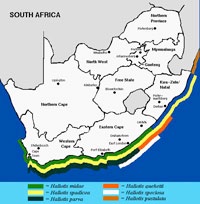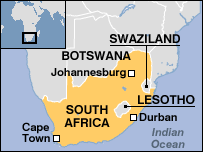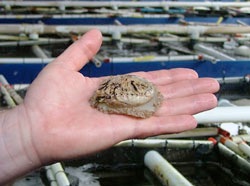South African Abalone Farming
From the farming of shellfish to the design of a system.
The Cold Benguela Current and the Poaching of Abalone
Imagine a coastal zone abundant with marine riches flowing to the coast of Africa thanks to the relentless Benguela current. This water is rich in nutrients with many types of abalone thriving in these waters. However, just on the coast there is abject poverty and water shortage. Why so in the middle of such natural abundance.
The reason is that abalone, as any other marine resource along the coast, is not seen as part and parcel of an eco-system. It is seen as an instant commodity ready to fetch instant profit in the export market. Asian culture believes that abalone delivers aphrodisiac powers, therefore the Asian market is willing to offer a high price for this shellfish. With poverty on one side, and wealth on the other it leads to the poaching of all the abalone. They are gone. So the only way abalone production has been dealt with so far is through policing and control - to satisfy the greed of the few, instill the fear in many.
The traditional offer on hand is to import abalone larvae from Japan. The idea is to invest in the production of abalone in tanks, designed by consultants. Based on the purchase of feed from an "expert" including animal waste mixed in the high protein concentrate, building a water treatment plant if we are lucky based on a purchase contract from an overseas client who is prepared to pay over five years, as long as the local investors take all the risk. It takes five years for the first cash to come! By the way, abalone only eat diatoms and seaweeds, they do not eat veggies or meat.
ZERI designs and philosophy offers another approach to abalone that thrives on the abundance of the local ecosystem and creates value for many, and navigates into something more co-evolutionary.
The science behind abalone
Abalone, like most metabolic animal species only absorb a fraction of the diatomic and algal nutrients into its body. The majority is simply processed through a sophisticated digestive system and released back into the seawaters where millions of micro organisms, and a few macro-species, especially the sea cucumbers (the earthworm of the sea) thrive thanks to the food residues of the abalone that are left astray in the ocean. The enzymatic mix of the digestive system in combination with a rich variety of anaerobic intestinal bacteria prepares food for other species that lies like debris on the ocean floor.
If no species were to absorb this waste, it would consume precious dissolved oxygen and thus decrease the vitality of life in the ocean, reduce biodiversity leading nutrient deficient waters. The inherent design of any ecosystem is an abundant one indeed. If mismanaged, an ecosystem can quickly lead to depletion and poverty for one and all.
The Cape Coastal Zone houses hundreds of families of microscopic and macro algae, some of which take the shape of sea bamboo (Ecklonia maxima), a kelp that can grow up to 15 meters long, thriving on thousands of nutrients, some mineral, some organic that are brought from Antarctica. Abalone solely feeds on diatoms (when it is a larvae) and algae (when it grows to maturity), and its larvae can only survive in the purest and richest waters of the world. This seashell animal is incredibly rich in trace minerals including iodine. the iodine reaches concentration levels that with a few abalones a year one would eliminate Iodine Deficiency Disorders (IDD) efficiently, one of the most debilitating illness in Africa after malaria and AIDS. All of the time and effort that we have spent to iodize salt for half a century could be substituted with investments in seaweed and abalone farming instead.
Designing Development with Natural Systems
The abalone farming is an interesting case in point. Just imagine these clean and nutritious waters. Just imagine the price the world is prepared to pay for a mature shell. Think of the high level of unemployment and the need to create a sustainable livelihood, while enhancing -and not just preserving- the natural systems. Just imagine a way to address all these agendas with one program while competing on international markets with a unique selling proposition based on local diversity of an endemic species.
By identifying the endemic abalone species in the waters enriched by the Benguela Current and studying the abalone hatching systems, the first input needed for a competitive production cycle is the diatoms. Diatoms live in the sea and farming is currently unheard of for the most part. A careful study of the abalone digestive system reveals the unique niche that each of the 200 odd varieties of diatoms play for each of the endemic abalones. One can chart the biochemical needs of each species by matching the nutritional preferences of each species with the biodiversity of the diatoms. These charts simply do not yet exist. This basic research is the key to success and is a first step in understanding the ecosystem.
Each endemic abalone has its unique portfolio of diatoms, which have evolved over millions of years to satisfy the specific role that each plays in a precisely defined niche. Then the same can be done for the seaweeds. Though the problem is that seaweeds contain alginates that are of little interest to the abalone. Though alginates are of great interest to the cosmetics industry. Thus, the cultivation of seaweeds for cosmetics leads to a regular harvest that is used to extract the alginates and the waste ... is used to feed the abalone. The cash flow from the seaweed farming is guaranteed by the cosmetics industry. The cosmetics industry has no waste to deal with which reduces its operating expenses, instead the waste is for the abalone. The investor does not have to carry a 5-year risk, since the feed for the seashells is secured by the investment in the cosmetics raw material production.
The creation of sustainable livelihoods depends on our capacity to access the science, process the information that nature unveils if we are prepared to look at the hidden connections, and then translate these into concrete projects. At present ZERI is developing this into a concrete plan...investors will decide if will pursue the turn-key export business or if there is a real chance for sustainable development, building on the local ecosystems, responding to the local needs, and providing the global market with a high quality product that is the result of a thriving biodiversity.

BOOK GUNTER PAULI FOR A CONFERENCE





